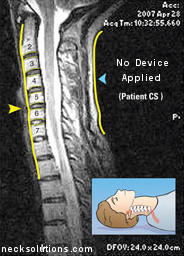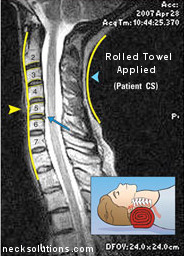Neck Traction Study Using MRI Comparison Of The Home Neck Traction Device
Neck traction study using MRI comparison of the neck with no device, an often recommended rolled towel and the home traction device.
 |
 |
 |
| With no device applied there is a minimal neck curve. There is a kyphotic buckle with stair-stepping and disc compression in the mid neck region. | The same patient with a rolled towel (passive device) applied shows a significant indentation (short blue arrow) but offers no relief from altered neck curve, stair-stepping or disc compression. There is a disc protrusion into the subarachnoid space at C5/6 (long blue arrow). | The same patient using the home neck traction. Note the neck curve has been restored, stair-stepping eliminated and the C5/6 disc protrusion is no longer visible. There is also dramatic disc expansion: over 50% at C5/6, over 40% at C4/5 and over 25% at C3/4. |
We have seen the neck traction study, now let’s see another neck traction study and what healthcare professionals are saying about the Home Neck Traction.
Dr. DM, a Chiropractor from Pennsylvania, indicated a patient of his, who was a 49 year old cabinet worker came in with numbness of the right hand which he had been suffering for approximately 6 months duration. MRI studies indicated bulging discs in the neck located from the third through sixth vertebrae. Nerve testing studies indicated the nerves were being pinched, resulting in obstruction of nerve flow to the hand.
The patient complained of neck stiffness which was worsening and his posture was altered. The patient had seen both an orthopedic doctor and a surgeon. Surgery was not recommended, so he starting using the home neck traction daily. Within 2 weeks he could feel benefits and 3 months later, he could feel normal sensation in his hand. A follow up MRI study was done and indicated reduction of all bulging discs in the neck. A follow up nerve test also indicated significant improvement!
 |
 |
Pre (left) – C. Colby, age 35 with a 13 degree or 131% lordotic reversal (from a 42 degree norm) at C-4/C-5 disc space (see arrow). Note how the C-5 and C-6 vertebrae are deforming to accept the increased load they must now shoulder. Further examine the collapse in disc space at C-4/C-5 (outlined) and C-5/C-6. This is the beginning of the “melted candle appearance” and “years of misery.”
Post (right) – C. Colby has reversed his kyphotic buckle and molded a 22 degree lordotic curve. This is a 35 degree or 83% improvement in just 20-min! (we’re shooting for a 5 degree or 131% change to a 42 degree norm) Note again the offending C-4/C-5 disc space (outlined). It has hydrated or expanded approximately 40%. Now, look closely where the stress lines drawn at the posterior vertebral bodies cross (arrow). Note after one Home Neck Traction treatment there is one stress point not two as in the pre (compare arrows). The C-4/C-5 joint is now properly sharing the load! If C. Colby will position the unit slightly higher and stick with the Home Neck Traction he can extend this reversal of kyphosis into lasting lordotic recovery.


